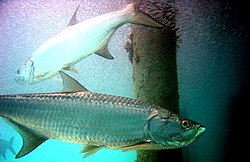Tarpon
| Tarpon Temporal range: Late Miocene to Present |
|
|---|---|
 |
|
| Atlantic tarpon | |
| Scientific classification | |
| Kingdom: | Animalia |
| Phylum: | Chordata |
| Class: | Actinopterygii |
| Order: | Elopiformes |
| Family: |
Megalopidae D. S. Jordan, 1923 |
| Genus: |
Megalops Valenciennes, 1847 |
| Species | |
|
Megalops atlanticus |
|
Megalops atlanticus
Valenciennes, 1847
Megalops cyprinoides
(Broussonet, 1782)
Tarpons are large fish of the genus Megalops; one species is native to the Atlantic, and the other to the Indo-Pacific Seas. They are the only members of the family Megalopidae.
The two species of tarpon are Megalops atlanticus (Atlantic tarpon) and the Megalops cyprinoides (Indo-Pacific tarpon). M. atlanticus is found on the western Atlantic coast from Virginia to Brazil, throughout the coast of the Gulf of Mexico, and throughout the Caribbean. Tarpon are also found along the eastern Atlantic coast from Senegal to South Angola.M. cyprinoides is found along the eastern African coast, throughout southeast Asia, Japan, Tahiti, and Australia. Both species are found in both saltwater and freshwater habitats, usually ascending rivers to access freshwater marshes. They are able to survive in brackish water, waters of varying pH, and habitats with low dissolved O
2 content due to their swim bladders, which they use primarily to breathe. They are also able to rise to the surface and take gulps of air, which gives them a short burst of energy. The habitats of tarpon vary greatly with their developmental stages. Stage-one larvae are usually found in clear, warm, oceanic waters, relatively close to the surface. Stage-two and -three larvae are found in salt marshes, tidal pools, creeks, and rivers. The habitats are characteristically warm, shallow, dark bodies of water with sandy mud bottoms. Tarpon commonly ascend rivers into freshwater. As they progress from the juvenile stage to adulthood, they move back to the open waters of the ocean, though many remain in freshwater habitats.
...
Wikipedia
